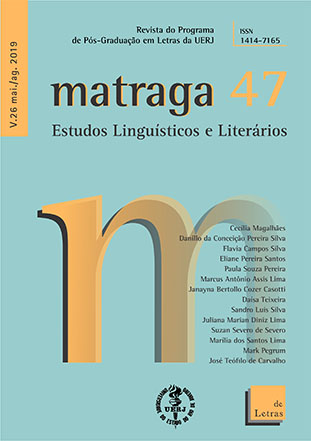Entre recortes, montagens e costuras: o mundo imaginado é um mosaico
DOI:
https://doi.org/10.12957/matraga.2019.38090Palavras-chave:
mundo imaginado, código, linguagem, pro-cessos inscricionais, mosaicoResumo
Meu principal objetivo nesse texto é discutir, tendo em vista os ensaios de Vilém Flusser sobre a reprodução das imagens técnicas e o futuro incerto da escrita, como os sistemas de reprodução linguística, em suas diferentes proposições, parecem apresentar um denominador comum, organizado em torno dos seus processos de materialização. Trato nesse caso desses processos não apenas consoante à intersecção de diferentes sistemas de linguagem, como é o caso do uso de estruturas visuais e pictográficas, dos caracteres verbais, da composição fílmica, entre outros. Trato também da peculiaridade compositiva desses rearranjos, organizados a partir de unidades estruturais em diferentes narrativas discursivas que também modificam-se pela própria evolução, reorganização e sobreposição de tais processos inscricionais. Para tanto, discuto a ideia desse complexo mosaico em confecção, consoante à ação criativa dos seus respectivos bricoleurs, ao fazer um paralelo entre as unidades estruturais dos códigos linguísticos com as unidades referentes aos códigos fílmicos, caso ilustrado aqui pela análise do vídeo educativo American Thrift como matéria-prima do videoclipe Cirrus.
Downloads
Downloads
Publicado
Como Citar
Edição
Seção
Licença
AUTORIZAÇÃO
A Matraga – Revista do Programa de Pós-Graduação em Letras da UERJ está autorizada a publicar o artigo ora submetido, caso seja aceito para publicação online. Fica atestado que a contribuição é original, que não está sendo submetida a outro editor para publicação, e que a presente declaração é a expressão da verdade.
Os trabalhos publicados no espaço virtual da Matraga – Revista do Programa de Pós-Graduação em Letras da UERJ serão automaticamente cedidos, ficando os seus direitos autorais reservados à Matraga. Sua reprodução, total ou parcial, é condicionada à citação dos autores e dos dados da publicação.

A Matraga utiliza uma Licença Creative Commons - Atribuição-NãoComercial 4.0 Internacional.





